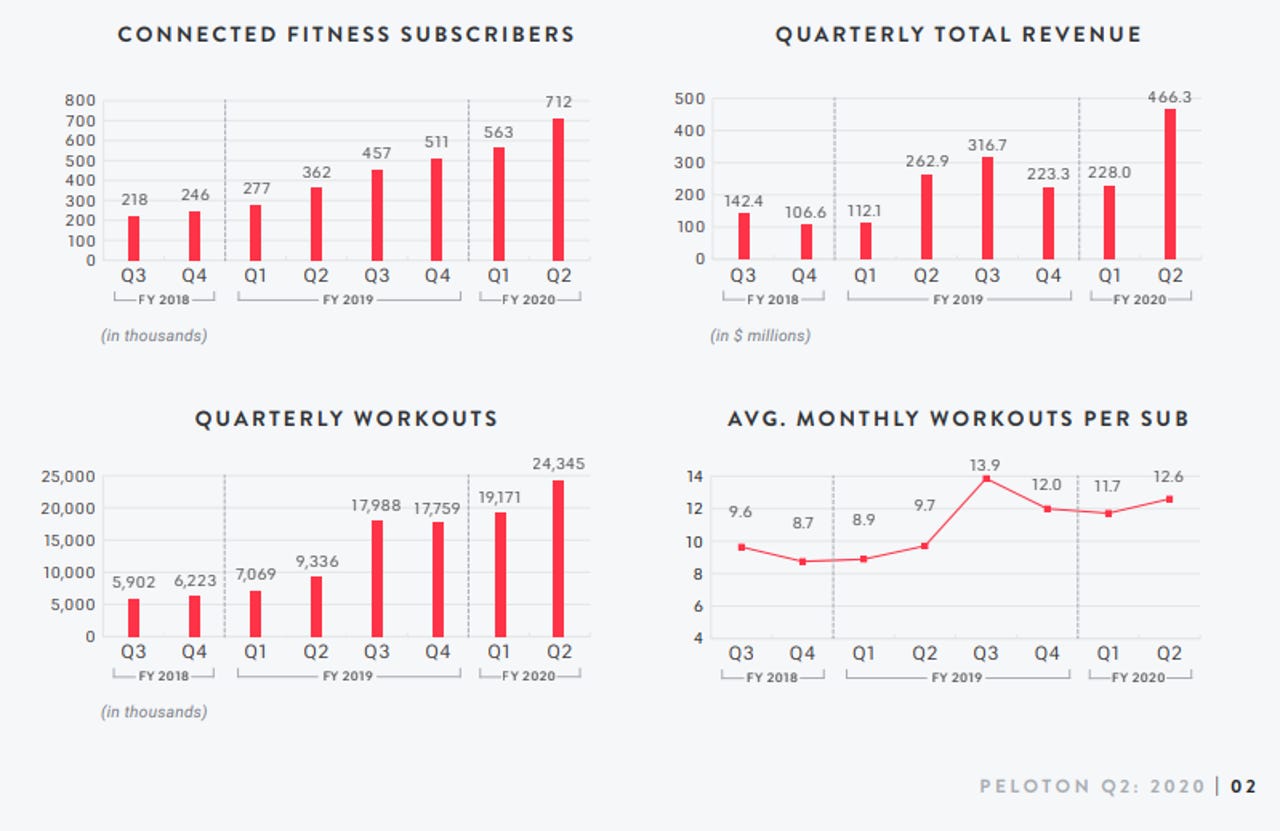Peloton's logistics, supply chain improvements bolster Q2 sales as company sees app as lead-gen tool


Peloton's second quarter revenue was higher than expected as the company was able to shorten the sales cycle and delivery window during the holidays due to supply chain and logistics investments.
Jill Woodworth, CFO of Peloton, said on an earnings conference call:
Given that Thanksgiving fell later in the year, the longer promotional period allowed us to better distribute our sales and deliveries to ensure bikes and treads arrived in time for the holidays. Our delivery sub scheduler, investments to scale supply chain logistics and seasonal hiring allowed us to achieve much shorter order-to-delivery times than in previous holiday period and versus our expectations.
The company, which bills itself as a technology, media and fitness outfit, reported fiscal second quarter revenue of $466.3 million, up 77% from $262.9 million a year ago. The net loss for the quarter was $55.4 million, or 20 cents a share.
- Best Peloton alternatives: Top smart exercise bikes
- Peloton has big ambitions, big IPO as competitors loom
- Peloton's subscriber base, Q1 losses surge as it acquires Tonic Fitness for more supply chain control
Wall Street was looking for fiscal second quarter revenue of $423.4 million with a loss of 36 cents a share.
The earnings report comes a day after Peloton settled its patent infringement suit against Flywheel. Flywheel agreed to cease using Peloton's technology.
Peloton's outlook was solid, and the company said that it is approaching the 1 million subscriber mark for fiscal 2020, but growth was below what Wall Street wanted and shares took a 10% hit afterhours.
On a conference call with analysts, Peloton CEO John Foley said:
We have strong conviction that consumers will continue to migrate to connected fitness experiences that offer better locations, better instructors, time-shifted consumption and a much broader and better selection of content. We do see other companies entering the connected fitness space from several different angles with digital streaming and/or hardware offerings with limited interactivity. But as the pioneer and clear category leader with an undeniable first-mover advantage, we plan to continue to invest smartly in new products, interactive software and innovative content across every major fitness vertical in order to maintain our lead.
Over time, our #1 goal is to make the Peloton experience more accessible to more people across all demographics. As we have discussed before, our long-term goal is to have a better best product portfolio. With high-volume scale production, marketing efficiencies and strong subscriber unit economics, we see an opportunity to pass savings on to the consumer, allowing us to broaden our reach and increase our addressable market. One important aspect of our strategy to maintain leadership in connected fitness is to also win in digital-only fitness.
For the third quarter, Peloton is projecting 843,000 to 848,000 connected fitness subscribers with revenue of $470 million to $480 million. For fiscal 2020, Peloton projected 920,000 to 930,000 connected fitness subscribers with $1.53 billion to $1.55 billion in revenue.
Foley said he wasn't worried about competition. "We are obviously not surprised that others are coming to realize the connected fitness opportunity, and we expect more investments on the part of competitors," he said.
Peloton will also be investing in software and hardware innovation. "It is my strong feeling that as an innovation company, innovation has been core to what we've been doing for the past 7 years, and we plan to continue innovating across hardware, software and content," said Foley.
Specifically, Peloton will be aiming to add more social and gamification features. "We do have a couple of really sexy social features in the queue for the connected fitness offering and for digital, for that matter. We have a lot of innovation in software. We have hundreds of the best Python and iOS and Android engineers in New York City writing code and working with some great product lines," said Foley. "They are going to help protect or move from a network effect perspective. When you think about social software and gamification, all of that, is a high priority for us because we know our members want it, and it's going to protect us and strengthen the moat for our business."
Key items:
- Peloton said that its omnichannel marketing, a longer Black Friday promotion period and free trials boosted conversion rates on its site.
- The company opened 15 new showrooms in the quarter to end with 96 globally.
- Peloton ended the quarter with 109,000 digital subscribers, or people that pay $12.99 for programs without connected fitness hardware. Peloton is betting it can upsell these subscribers to equipment, but also noted that more than 75% of Peloton Digital subscribers took floor-based classes such as strength training, stretching and yoga. Foley added that Peloton Digital is a strong lead generation tool and the company is seeing strong organic conversion from digital subscribers to connected fitness products.
- Connected fitness subscribers worked out with Peloton 24.3 million times in the second quarter.
- The average net monthly connected fitness churn in the second quarter was 0.74%.
- 92% of connected fitness subscribers were on month-to-month plans.
- Engagement in the second quarter grew as subscribers had 12.6 average monthly workouts, up from 9.7 a year ago.